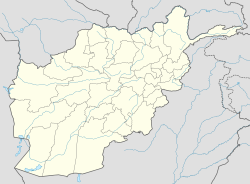Kabul
| Kabul کابل | |
|---|---|
| — City — | |
| Central Kabul is situated 5,900 ft (1,800 m) above sea level in a narrow valley, wedged between the Hindu Kush mountains | |
| | |
| Coordinates: 34°31′59″N 69°09′58″E / 34.53306°N 69.16611°ECoordinates: 34°31′59″N 69°09′58″E / 34.53306°N 69.16611°E | |
| Country | |
| Province | Kabul Province |
| No. of sectors | 18 |
| Government | |
| - Mayor | Mohammad Yunus Noandesh |
| Area | |
| - City | 275 km2 (106.2 sq mi) |
| - Metro | 425 km2 (164.1 sq mi) |
| Elevation | 1,790 m (5,873 ft) |
| Population (2008) | |
| - Metro | 2,850,000 |
| [1] | |
| Time zone | Afghanistan Standard Time (UTC+4:30) |
Contents[show] |
[edit] History
| History of Afghanistan |
|---|
| See also |
| Ariana · Khorasan |
| Timeline |
[edit] Antiquity
Alexander took these away from the Aryans and established settlements of his own, but Seleucus Nicator gave them to Sandrocottus (Chandragupta), upon terms of intermarriage and of receiving in exchange 500 elephants.[4]—Strabo, 64 BC–24 AD

| “ | The Yueh-ci of the Chinese, of whome the Kushans were a branch, are believed to have been of Turkish origin, but it is probable that they were partly of Iranian blood and culture, which would have rendered easier their assimilation by the pre-existing Iranian population (including the Sakas). The portraits on their coins show them as sturdy bearded men with long noses, in fact of the type still prevailing among Afghans and Tadjiks; their language seems to have been (or to have rapidly become) Iranian, and the Gods they worshipped were mainly Persian. Their home before they were attacked by the Hiung-nu was in Chinese Turkistan where recent discoveries show the early civilization to have been mainly Iranian and the language identical with that of Sogdiana. They probably assimilated other Iranian elements during their residence in the Oxus country, and learnt something also from the Greek princes whose coins they imitated, although their knowledge of Greek was much less perfect than that of the Sakas, and they often used Persian words written with Greek letters.[11] | ” |
Kábul was formerly governed by princes of Turk lineage. It is said that they were originally from Tibet. The first of them was named Barhtigín, * * * * and the kingdom continued with his children for sixty generations. * * * * * The last of them was a Katormán, and his minister was Kalar, a Bráhman. This minister was favoured by fortune, and he found in the earth treasures which augmented his power. Fortune at the same time turned her back upon his master. The Katormán's thoughts and actions were evil, so that many complaints reached the minister, who loaded him with chains, and imprisoned him for his correction. In the end the minister yielded to the temptation of becoming sole master, and he had wealth sufficient to remove all obstacles. So he established himself on the throne. After him reigned the Bráhman(s) Samand, then Kamlúa, then Bhím, then Jaipál, then Anandpál, then Narda-janpál, who was killed in A.H. 412. His son, Bhímpál, succeeded him, after the lapse of five years, and under him the sovereignty of Hind became extinct, and no descendant remained to light a fire on the hearth. These princes, notwithstanding the extent of their dominions, were endowed with excellent qualities, faithful to their engagements, and gracious towards their inferiors...[18]—Abu Rayhan Biruni, 978-1048
[edit] Islamic conquest to the Mongol invasion

"Kábul has a castle celebrated for its strength, accessible only by one road. In it there are Musulmáns, and it has a town, in which are infidels from Hind."[20]—Istahkrí, 921
We travelled on to Kabul, formerly a vast town, the site of which is now occupied by a tribe of Persians called Afghans. They hold mountains and defiles and possess considerable strength, and are mostly highwaymen. Their principle mountain is called Kuh Sulayman.[22]—Ibn Battuta, 1304–1369
[edit] Timurid and Mughal era

In the country of Kābul there are many and various tribes. Its valleys and plains are inhabited by Tūrks, Aimāks, and Arabs. In the city and the greater part of the villages, the population consists of Tājiks . Many other of the villages and districts are occupied by Pashāis, Parāchis, Tājiks, Berekis, and Afghans. In the hill-country to the west, reside the Hazāras and Nukderis. Among the Hazāra and Nukderi tribes, there are some who speak the Moghul language. In the hill-country to the north-east lies Kaferistān, such as Kattor and Gebrek. To the south is Afghanistān... There are eleven or twelve different languages spoken in Kābul: Arabic, Persian, Tūrki, Moghuli, Hindi, Afghani, Pashāi, Parāchi, Geberi, Bereki, and Lamghāni...[23]—Babur, 1525
[edit] Durrani Empire and the Afghan nation-state


[edit] Soviet invasion and civil war

[edit] US-British invasion
NGOs
[edit] Gallery
| Bagh-e Babur from a mountain top | |||
















